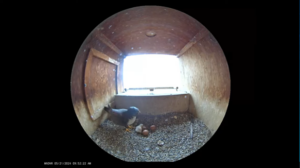Peregrine falcon chick visible on DNR FalconCam

Falcon Cam – Minnesota Department of Natural Resources
Minnesota DNR
First egg has hatched
The first of four peregrine falcon eggs in the DNR FalconCam (mndnr.gov/falconcam) nest box has hatched and a chick is now visible. The popular webcam, live streaming from a nest box on a high rise in downtown St. Paul, will once again capture a peregrine falcon pair raising their chicks.
The first chick hatched early in the morning on May 21, making its first appearance on camera at 6:22 am. A four-egg peregrine falcon clutch, such as this one, typically hatches over a 24-48 hour period, so any further hatching should occur within the next couple of days. The first sign of a hatch is a small hole, called a pip, as the chick begins the process of emerging. It can take the chick up to 72 hours from starting a pip to hatching. This initial stage may be difficult to observe on the FalconCam, but if another egg does hatch, FalconCam viewers will get a glimpse of the chicks’ pink and white downy heads when the adults begin feeding them.
“The DNR FalconCam provides a window into the fascinating world of nesting birds for all to enjoy,” DNR Nongame Wildlife Engagement Supervisor Jessica Ruthenberg said. “We hope this live webcast generates appreciation for peregrine falcons and Minnesota’s other nongame wildlife.”
Falcon chicks, called eyasses, are relatively helpless when they first hatch, spending much of their time resting and sleeping. Brooding duties and feeding of newly hatched chicks are typically done predominately by an adult female falcon, with an adult male providing some support. Over the first few weeks of life, chicks are brooded less and less, grow a second coat of white down and gradually become more active.
The FalconCam became the DNR’s first live webcam 13 years ago. Building tenants at Sentinal Properties provide funding for the live camera stream and the building managers oversee the nest box and camera. The webcam provides an intimate view into the life of nesting peregrine falconseach year.
The two adult falcons using this nest box have been identified by the Midwest Peregrine Society as an 11-year-old female and a 15-year-old male. This female falcon has nested in this box since 2016. The male, banded as a chick in 2009 in Indiana, is a new partner for the female.
The peregrine falcon story is a Minnesota success. In the 1970s, they were on the brink of extinction in North America. Populations were restored with the help of Minnesota falconers, the Midwest Peregrine Society and the DNR Nongame Wildlife Program. Donations from generous Minnesotans on income tax forms helped to fund the peregrine falcon restoration project and the DNR FalconCam.
Since 1987, Minnesotans have been able to “look for the loon” on state individual income tax forms to fund projects like the peregrine and eagle web cameras. There are many ways to make a donation (mndnr.gov/nongame/donate) for the future of Minnesota’s nongame wildlife any time during the year.
The DNR FalconCam (mndnr.gov/


